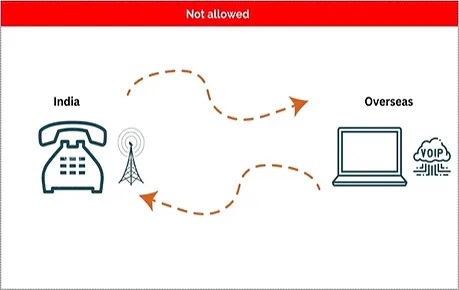Technology, especially in the means of instant communications, has seen rapid and unparalleled growth all across the globe in the past decade. This has been made possible in part through Internet Protocol (IP) based networks, that continue to touch upon all the sectors around the world, due to a multitude of applications and, particularly, due to Voice over Internet Protocol (VoIP).
In this article, we examine the regulatory status of VoIP in India, and try to 'crystal gaze' towards its future status. The term VoIP and Internet Telephony are often interchangeably used, with the term "Internet Telephony" being primarily used and referred in the recommendations by Telecom Regulatory Authority of India (TRAI) as well as the Licensing Conditions prevalent in India.
VoIP is (simply put) voice transmitted over packet switched network using the IP. It enables users to make real time voice/video calls, thereby reducing the underlying cost of a traditional telephone call. TRAI in its Recommendations on Regulatory Framework for Internet Telephony released on October 24, 2017 ("TRAI 2017 Recommendations") noted that there are two methods, which have been recognized globally for voice transmission over IP networks, based on the type of IP network used –
(i) VoIP i.e., voice is transmitted over managed IP network and
(ii) Internet Telephony i.e., voice is transmitted over public Internet.
The primary difference between voice services on managed and unmanaged IP network is the quality of speech, which difference currently on account of technological advancements, new coding techniques and availability of higher bandwidth broadband connections, is getting further narrower.
Historically, the Indian Department of Telecom had issued guidelines for the first time to offer Internet Telephony on April 1, 2002, albeit with restricted use. Since then, TRAI had issued various recommendations and consultation papers, with the last 'Consultation Paper' being released on 2016 i.e., Consultation Paper on Internet Telephony (VoIP), which sought to identify issues in providing Internet Telephony Services and address them in a holistic manner.
TRAI 2017 Recommendations was the outcome of the said Consultation Paper and public comments received.
On the regulatory front and in short, VoIP services are regulated, and a license is needed to provide them as explained below.
Deployment Scenarios
TRAI's 2017 Recommendations stated three main deployment scenarios for IP Telephony:
- PC to PC: Existing licensing conditions of Internet Service Providers (ISP) allows parties (caller + recipient) through the means of their computers/ smartphone/ tablets and compatible software, to connect to the public internet and exchange voice/data.
- Phone to Phone: In this case, the caller and recipient use their telephone set (fixed/mobile) for voice communications, through established gateways over managed IP network.
- PC to Phone or Phone to PC: One of the party (caller/recipient) has a computer which he connects to the Internet via access network and a licensed ISP, while the other party is a normal subscriber of a telephone network (fixed/mobile) viz.Public Switched Telephone Network (PSTN) through a licensed Telecom Service Providers (TSP).
The present regulatory framework, allows the first two [(i) and (ii)] deployments. For the third one (iii) above, the Licensing Conditions allows Internet Telephony from PC to PSTN abroad but, prohibits use of E.164 numbering as well as voice communications, to and from a telephone connected to a public network (PSTN) in India, which is diagrammatically represented below:

Arguably, the reason behind the said prohibition is to prevent "toll bypassing" of STD/ISD calling mechanism and tariffs, as each and every call would then be initiated as a local call, if allowed. In fact, TRAI 2017 Recommendations also state that when in 2007/2008 unrestricted Internet Telephony for ISPs were deliberated, the main argument given by TSPs for not allowing the same was that it would impact their business model on account of reduction of voice traffic on their network and would disturb the level playing field among different licensee, especially since TSPs have paid huge entry fee and made heavy investments to create infrastructure.
On a separate note, OSPs (Other Service Providers) carrying out voice based BPO services are specifically regulated by the Revised Guidelines applicable for Other Service Providers dated June 23, 2021, for which you can refer to our earlier update here.
What the Future Holds
The restrictions and controversy around VoIP sounds quaint in the 2020s, where video calls over the Internet are ubiquitous. But the prohibition on interconnection is a major part of current Indian telecom regulations.
With the growing liberalisation of the telecom sector, it may not be farfetched to predict that VoIP may soon replace traditional PSTN as the primary mode of voice and/or data communication. In fact, as per TRAI 2017 Recommendations, the total volume of packet-based network traffic has surpassed traditional circuit switched network traffic viz. PSTN. This doesn't come as a surprise considering the technological advancement in the sphere of smartphone advancements, new voice coding techniques and availability of high speed internet. Most of the TSPs in India have now IP based core transport network for carrying voice and data traffic.
Hence, if your business uses or touches upon VoIP technology, or if you intend to move from traditional telephone services to VoIP system for your back office, then it is recommended to get the call routing process assess and evaluated, so as to ensure that there is not any illegal and/or unauthorised voice traffic in the process adopted by your business.
The content of this article is intended to provide a general guide to the subject matter. Specialist advice should be sought about your specific circumstances.

